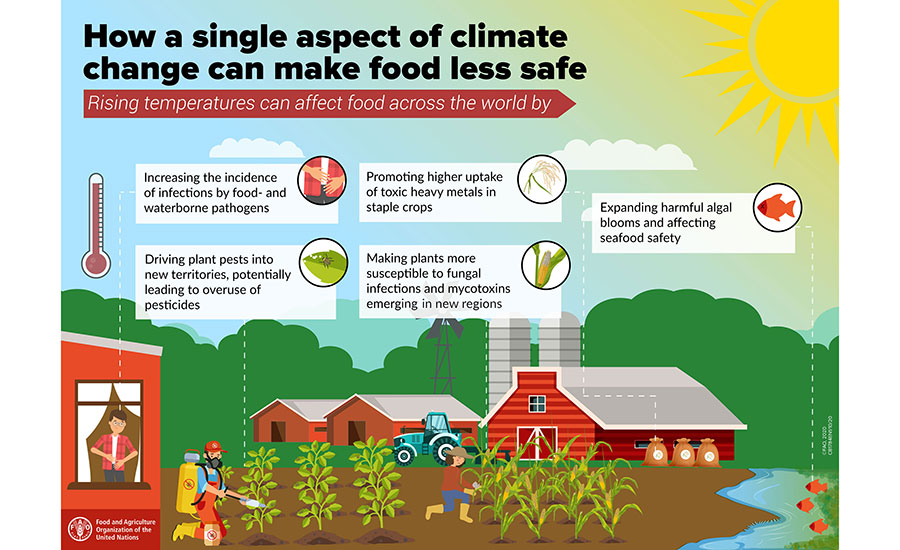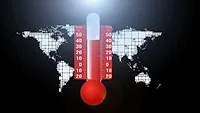How Is Climate Change Affecting the Safety of Our Food?

Under the best circumstances, agriculture can be a tough business. Today, increasing pressures on the world’s land and water resources are jeopardizing humanity’s ability to feed itself. Exacerbated by climate change, these pressures are making agriculture a more vulnerable and challenging enterprise. Elevated temperatures, changes in water availability, deteriorating soil quality, extreme weather events, rising sea levels, and ocean acidification, among other factors, can have an impact on food production, processing, storage, and distribution, right up to the moment it reaches our tables. In other words, our entire food system is threatened by climate change.
Ensuring food safety at every step from farm to fork means that farmers, producers, and the agri-food sector as a whole need to prepare for and respond to threats throughout the supply chain. And this work is now more complicated with the changing climate, which can make food unsafe in myriad ways (see “Identifying the Cause of a Foodborne Disease Outbreak Is Now More Complex Because of the Globalized Food Chain and Climate Change,” below).
Farmers are finding it increasingly difficult to consistently grow sufficient food that is also safe, as a growing population drives up demand while a changing climate often results in lower crop yields and exacerbates food safety concerns, taking a toll both in the field and after harvest (see “Climate Impacts on Food Safety Can Hamper Efforts to Achieve Food Security,” below). The negative impacts of warming oceans and elevated acidification on the aquatic ecosystems and on fisheries across the world are already observable. Soaring temperatures can cause heat stress in livestock, elevating the potential for zoonotic pathogens to spread.
Extreme events are becoming more frequent, severe, and unpredictable. Such incidents destroy fields, disrupt food chains, cause food shortages, and in almost all cases increase the occurrence of foodborne hazards. Prolonged droughts and floods, as well as saltwater intrusion from rising seawater levels, can make areas uninhabitable for people, animals, and wildlife, leading to migration. Populations displaced due to climate change can be at high risk of not having access to enough safe food and water. And competition for limited resources might compound vulnerabilities by sparking conflicts within communities as well as leading to a larger intrusion of humans into wildlife habitats, increasing the risk of zoonotic diseases.
In 2008, the Food and Agriculture Organization of the United Nations (FAO) highlighted the significant impacts climate change has on the safety of our food, posing substantial challenges to global sustainability and development. The publication, Climate Change: Implications for Food Safety, provided a broad overview of climate change impacts on specific food safety issues. In 2020, a new FAO report—Climate Change: Unpacking the Burden on Food Safety—reviewed the effects of climate change on various hazards that can enter the food chain and attempted to quantify some current and anticipated food safety issues associated with the changing climate.
This article draws on that research to outline some of the ways climate change can increase consumer exposure to contaminants through food.
Climate Change Increases Food Safety Risks
Climate change has multifaceted impacts on the occurrence and severity of food safety hazards. A single environmental factor like rising temperatures can trigger varying degrees of effect on different contaminants—for instance, strengthening the chances of survival of foodborne pathogens (like Salmonella and Vibrio) as well as altering the occurrence patterns of chemical contaminants (like aflatoxins and arsenic). Due to the complex nature of these effects, it can be difficult to quantify them.
Looking for quick answers on food safety topics?
Try Ask FSM, our new smart AI search tool.
Ask FSM →

Changes in temperature, precipitation, and other environmental factors are affecting the geographic distribution and persistence of foodborne pathogens and parasites. For instance, the risk of infections by both Salmonella spp. and Campylobacter spp. has strong associations with rising temperatures. Vibrio vulnificus is a major foodborne pathogen that causes illnesses, sometimes fatal, through the consumption of raw or undercooked seafood. Warming oceans and rising sea levels are conducive to the growth and distribution of this pathogen. Frequent and severe hurricanes cause recurring flooding of croplands, which could distribute pathogens into the food chain. This can pose specific food safety risks, especially if the produce is consumed raw. Flooding also increases risks of outbreaks of waterborne diseases like cholera (caused by Vibrio cholerae), especially in areas where basic public infrastructure for hygiene and sanitation is inadequate or lacking. Shifting rainfall patterns and higher temperatures in the temperate areas can favor the establishment of foodborne parasites, which are usually more common in the tropical regions.
Prolonged droughts can alter the availability and usage of water in a given area. This can affect businesses such as food processing plants, where water use for cleaning and sanitation may be restricted, which can compromise food safety. Power outages are common during extreme weather events, and this can affect the storage conditions of food in homes and in retail stores.
Algal blooms
Algae are a natural component of the aquatic ecosystem. Algal blooms occur when certain algae grow out of control due to various environmental and anthropogenic conditions and can occur in both freshwater and marine environments. Such blooms can block out sunlight from all other marine plants and animals. When the algal blooms die and decompose, they deplete the area of the available oxygen, creating “dead” zones that are uninhabitable for other forms of life. Today, many of these dead zones are in major fishing areas.
Certain algal species also produce toxins that are harmful to fish, shellfish, marine mammals, and birds. These algal toxins can bioaccumulate in fish and shellfish and induce toxic syndromes in humans when consumed. For instance, ciguatera poisoning is caused by ciguatoxins and is a major foodborne issue in the Pacific region. These harmful algal blooms also affect the surrounding water quality, destroy coastal resources, affect both fisheries and tourism industries, and cause massive economic losses.
Overabundance of nitrogen and the application of phosphorus-rich fertilizer combined with intense precipitation, warmer seas, ocean acidification, and food web modification due to overfishing, among other factors, have led to increased frequency and duration of harmful algal blooms along coastlines and in lakes globally. Climate change is enabling various species that form harmful algal blooms to expand to new areas, most of which are not prepared to address the challenges of detection and surveillance, thereby putting public health at risk.
Heavy metals
Metals like cadmium, lead, and mercury, as well as metalloids like arsenic, occur naturally in the environment (soil, air, water). While not a true metal, arsenic is often considered together with all other toxic heavy metals. These heavy metals can also be found in food due to their presence in the environment or as a result of anthropogenic activities and contamination during food production and storage.
Methylmercury in fish is a major public health concern as it has toxic impacts on the nervous, immune, and digestive systems of humans. It is also a threat to the development of a child in utero as well as in early life. Rising temperatures are causing permafrost regions to thaw, releasing large, historically trapped quantities of mercury into bodies of water. Mercury in its inorganic form becomes methylated in our aquatic systems; this process is affected by a number of environmental factors that are influenced by climate change. The bioaccumulation of methylmercury in the aquatic food chain is also affected by warming seas and ocean acidification.
On land, heavy rainfall, especially in mining areas, can release various toxic metals into the surrounding areas, compromising food and water quality. In addition, rising soil temperatures can facilitate the uptake of toxic metals by plants, for instance, arsenic in rice. This is a public health concern as rice is known to accumulate arsenic not only in the plant but also in the grain, which is widely consumed in a number of low- and middle-income countries.
Mycotoxins
Dietary exposure to mycotoxins can occur either directly through the consumption of contaminated food or indirectly via the consumption of products derived from animals raised on contaminated feed. Temperature, relative humidity, and crop damage by pests are some of the major factors that influence fungal growth and mycotoxin production in crops. All these factors are affected by climate change. With cooler temperate zones becoming warmer and thus more conducive to agriculture, they are opening up new habitats for agricultural pests and toxic fungal species. Aflatoxins, which were traditionally considered a problem in tropical areas (such as in some parts of Africa), are now quite established in other geographical zones and regions. Migration of mycotoxins into areas that lack the capacity for surveillance and outbreak management make it difficult to curtail damage to local economies and impacts on public health. Inadequate storage and transportation infrastructure, especially under climate change conditions, in addition to lengthening food chains, is increasing the risk of production and dissemination of mycotoxins like aflatoxin and ochratoxin.
What Can Be Done?
Raising awareness of the issue through targeted communication: Raising awareness of an issue is a critical step for creating an environment where effective measures can be formulated to prevent and manage food safety risks. For instance, if the general awareness of aflatoxins is high in a country, the public tends to support the development of adequate regulations to control them. The country can then enjoy access to the international market and a safe domestic food supply.
Effective user-centric communication strategies are needed to engage different stakeholder groups. Audience segmentation has the advantage of conveying messages aimed at inspiring action by specific groups, so information campaigns and initiatives should have messages tailored to audience and objectives.
Engaging all stakeholders: Collaboration among all stakeholders is necessary—from assessing food safety risks and leveraging knowledge to selecting the appropriate risk management measures and coordinating interventions across the national food supply chain. Local foodborne incidents can quickly become international emergencies, making the need for multinational as well as transdisciplinary (agriculture, health, environment, commerce, trade) collaboration very important. A holistic, integrated cross-sectoral approach to food safety—in other words a “One Health” approach—is ideal for bringing about a synergistic mindset especially in the face of climate change. Stronger collaboration across disciplines will help focus expertise and resources on specific issues, avoid the duplication of efforts, and provide holistic solutions to challenges. Managing food contamination risks under climate change requires the engagement of various actors in the food chain—the food industry to make our food safely, national authorities dealing with sanitary and phytosanitary issues to ensure that laws and incentives are set toward ensuring food safety, national laboratories to verify our food safety process works correctly, and academia to produce knowledge and experts in food safety. This collaboration should also include nongovernmental organizations.
Fostering greater surveillance and data sharing: Rigorous risk assessments are needed to establish appropriate food safety standards, which must be periodically revised in line with evolving science and the data collected from monitoring and surveillance. Appropriate surveillance data from different stages of the food production chain and on human diseases must be collected in tandem, analyzed to evaluate trends, and shared transparently with all relevant national and international partners. Data integration will contribute significantly to the prediction and thus prevention of foodborne disease outbreaks. However, few countries routinely collect and share such data. Effective monitoring and surveillance of food safety risks depends heavily on the availability of adequate resources. The disparities between low-, middle-, and high-income countries in terms of these necessities make it challenging to procure and implement new technologies for outbreak surveillance.
Strengthening food safety management: Food safety systems are managed differently in different countries. Therefore, appropriately harmonized management at an international level is difficult given the diverse capacities, infrastructure, and validation methods needed to handle the complexities of the supply chains. Adopting good-practices guidelines and establishing effective food safety systems are vital to ensuring the safety of national food supplies as well as products for export. An essential part of this work is the adoption and enforcement of food safety standards and the harmonization of regulatory frameworks for food that is destined for domestic consumption as well as trade—at the regional and international levels.
Investing in early warning systems: Routine monitoring systems for food safety hazards may miss the occurrence of new or emerging hazards in food. Early warning systems form an important element of the risk-reduction approach to prepare for the food safety challenges induced by climate change. Greater investments are needed to set up widespread early warning systems in climate-vulnerable countries.
Adopting forward-thinking attitudes: Relying on approaches such as foresight helps anticipate future challenges and perpetuates resilience by continually updating preparedness. Foresight is not about predicting the future: It is a structured approach to gathering and interpreting intelligence, upon which proactive strategies are then built to identify future challenges and mitigate their impacts. Such approaches are also a great tool to optimize future opportunities as they arise. Foresight should not replace traditional surveillance and monitoring systems but rather should be introduced to complement them and take a holistic view of the potential issues that may require risk management measures. Foresight also supports early warning systems by facilitating the prioritization of resources and the development of relevant strategies.
Advancing current knowledge through further research: Numerous gaps remain in the global understanding of how climate change affects food safety. To gain better understanding, there is a need to encourage more studies that investigate these effects and the exposure risks that they pose—individually and in combination of multiple hazards.
Conclusions
The combination of the complexity of food systems and the diversity of foodborne hazards that are simultaneously affected by changing climatic factors is making risk prioritization quite challenging. Prioritization of food safety risks is a systematic analysis, usually carried out by national food safety authorities, whereby various foodborne hazards are ranked based on the likelihood and severity of adverse impacts on human health in the domestic population. Such processes allow resources to be allocated effectively to minimize risks of foodborne illnesses. Risk ranking can be a tool to direct investments to priority areas. This is especially important in countries with limited human and financial resources, which can make it difficult for national authorities to effectively address all food safety threats.
In the context of climate change implications for food safety, consumers have an important role to play. Indeed, their influence will need to be considered by national/regional authorities as they take into account the way food systems are changing. Urbanization, globalization, financial restrictions or gains, growing interest in sustainability in food production, and more are altering consumer choices and dietary patterns. Government bodies need to be aware of new threats to food safety that bring changes to production systems and also how to capture the momentum to help drive change. The onus for empowering consumers to make healthy choices in the context of sustainable food systems is a shared responsibility that falls on government bodies, the agri-food industry, consumer associations, media outlets, educators, and the scientific community at large.
Keya Mukherjee, Ph.D., is a food safety specialist in the Food Systems and Food Safety Division at the FAO.
Mia Rowan is a program specialist in the Food Systems and Food Safety Division at the FAO.
Vittorio Fattori, Ph.D., is a food safety officer in the Food Systems and Food Safety Division at the FAO.
The views expressed in this publication are those of the author(s) and do not necessarily reflect the views or policies of the Food and Agriculture Organization of the United Nations. © FAO, 2021.
Global food supply chains are not new—spices, sugar, and cocoa have all had vast distribution networks for centuries. However, today’s food supply chains have to move larger volumes at a greater speed to meet the growing demand in all corners of the world. The current distribution networks can also amplify food safety concerns as food products are usually combined from a variety of sources and then distributed over a large geographic area in a relatively short time span. Adding climate change to this already-complex food safety landscape ups the ante. Systematic monitoring of food and environmental contaminants can help quickly identify potential foodborne risks in the food chain. Combining this with technology-driven traceability will facilitate tracking and removing contaminated food products before they become a public health issue.
The lengthening of supply chains and the disruption of food supplies and effects on food safety by climate change can present an increasing challenge for countries that tend to import a majority of their food, for instance, small island states. In these contexts, food safety managers and regulators need to be extra vigilant on how the changing production system could affect food safety risks and ensure that appropriate controls are in place.
Unsafe food is unfit for consumption and cannot sustain human health. Malnutrition and impaired immune systems make people more susceptible to foodborne pathogens and toxins, leading to more foodborne diseases. Furthermore, certain foodborne pathogens and parasites can reduce our capacity to absorb nutrients, thereby compounding malnutrition. This vicious circle is a major issue especially in populations that live in food-insecure regions.
Having sufficient food is often associated with food security. However, this is an oversimplification, as achieving food security involves access to food that is sufficient, nutritious, and safe. So, food safety is a key part of food security.
A major foodborne hazard that also has severe implications for food security is mycotoxins, which are toxic metabolites produced by various fungal species that contaminate many staple food and cash crops (e.g., maize, peanuts, nuts, rice, spices). A well-known example of a major mycotoxin is aflatoxins. When crops are subjected to stress conditions, like high temperatures and drought, they become more susceptible to infections by fungi like Aspergillus flavus, which produce aflatoxins. There is evidence to show that climate change is driving the expansion of such fungal species into areas that were once outside their natural niche. Changing climatic conditions are also facilitating the growth and expansion of agricultural pests, as we have recently seen with the migration of locusts from the Horn of Africa. Insects can carry fungal spores that are introduced inside plants when they feed. Moreover, plants that are stressed due to pest damage are more susceptible to fungal infections. Poor postharvest techniques for drying, storage, and handling as well as inadequate transportation conditions also increase the risks of aflatoxin production. It is difficult to destroy aflatoxins, as normal processing methods do not affect the toxin levels much. Exposure to these toxins increases the risk for liver cancer and increasing evidence suggests its association with stunting in children.
Due to the serious health effects of such toxins, their presence in crops is restricted by regulatory limits in most countries. However, countries that may face more challenges with aflatoxin contamination often lack effective food safety capacities and food control systems. This can in turn lead to exclusion of certain food commodities from the export market, resulting in economic losses. Local communities might be exposed to mycotoxins if crops rejected from international markets enter the domestic food supply. In addition, using such contaminated crops as animal feed can lead to further food safety risks (as toxic metabolites can be present in animal products like milk) as well as increased disease burden in livestock, also resulting in economic loss.








